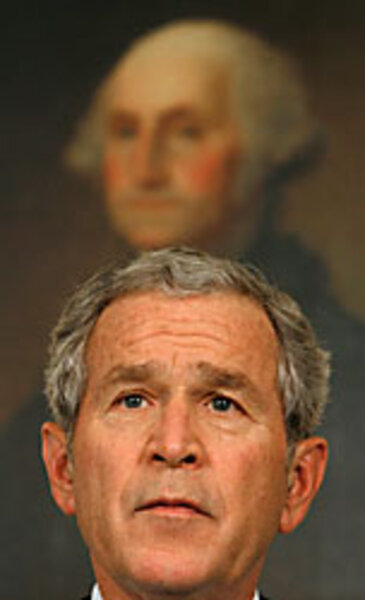Is the U.S. doing enough to alleviate the world food crisis?
Loading...
| Washington
The Bush administration is pushing for an increase in US food aid and more flexibility in aid delivery at a time when natural disasters and soaring prices are threatening to spread hunger among some of the poorest in the world.
Critics point out that the new money wouldn't start flowing until 2009 – and that aid-policy changes could well be halted by US agricultural politics.
But many private aid groups still welcome the proposed moves as a sign of US engagement with a complex international problem – food shortages – that is unlikely to abate anytime soon.
"We really welcomed the president's announcement," says Robert Zachritz, US director of advocacy and government relations for World Vision, of President Bush's proposal of $770 million in new aid. "This administration deserves credit for responding to the current global food crisis in a significant way."
Burma (Myanmar) is the latest hard-hit nation where world aid groups are scrambling to get food to those who need it.
The US, for its part, has provided $250,000 in aid from an existing emergency fund to help international groups present on the ground, such as the UN's World Food Program, provide rice and other necessities.
President Bush on May 6 called on Burma's military junta to allow US disaster assessment personnel into the country in the wake of the cyclone that devastated the country May 3.
"The United States has made an initial aid contribution but we want to do a lot more," said Bush at the White House. "We're prepared to move US Navy assets to help find those who have lost their lives, to help find the missing, to help stabilize the situation."
Further US aid is not necessarily contingent on access for US personnel. The US could continue funneling its help through international groups.
Soaring prices for rice and other commodities have already spread hardship throughout many less-developed nations – particularly in Africa. At least five people were killed in food riots in the Somali capital of Mogadishu on May 5. Cameroon, Burkina Faso, and Egypt recently have suffered similar unrest.
Bush's proposed $770 million in new food aid to help the world deal with spreading hunger, added to $200 million in extra funds released in April, would bump total US food assistance for 2008 and 2009 to $5 billion.
This infusion, if approved by Congress, would be welcome, say experts. In general, the US provides about half of global food aid, as measured by value.
But the $770 million would do little to help the hungry in Burma, Haiti, or other nations now identified as problems by the US Agency for International Development's Famine Early Warning System. That's because the Bush proposal is for the fiscal year 2009 budget.
"The concern is how soon these commitments can be realized. There is definitely a lag time when it comes to assistance," says Noam Unger, senior manager of the Foreign Aid Reform Project at the Brookings Institution in Washington.
On May 1, Bush also repeated his previous call for Congress to approve a major change in how US food aid is delivered.
Currently, most aid is provided in the form of US-grown commodities bought by the government and shipped to trouble spots. The White House wants to be able to spend at least 25 percent of aid money overseas, buying local food directly from local providers.
That would increase efficiency of aid delivery and help develop local agricultural markets, which in turn could ease hunger in the long run, say experts.
In the past, US farm politics has prevented this move. US food aid programs have been backed by farm state lawmakers partly as a way to boost constituents' incomes.
But with ethanol production pushing corn prices higher, and prices for commodities generally high, farmers might accept the "untying" of a percent of food aid, say some.
"This could be an opportunity to make some innovative changes in terms of how the US provides food aid," says Mr. Unger.
In recent years most developed nations have switched from commodity to cash aid. But the big US farm bill now under consideration by lawmakers may not include the switch when it emerges from Congress, perhaps later this week.
For this and other reasons, the Bush administration has made noises about vetoing the farm bill – meaning the political future of the untying of food aid remains unclear.





